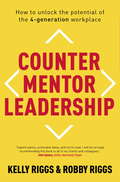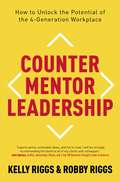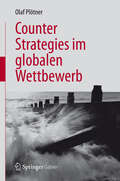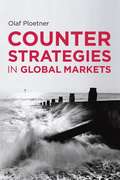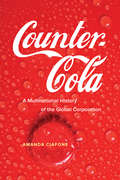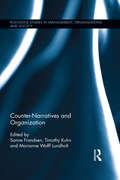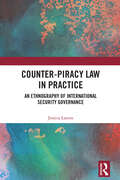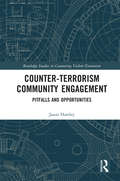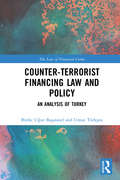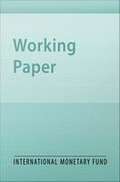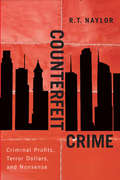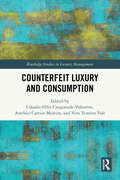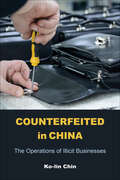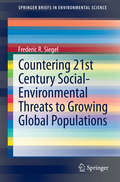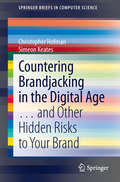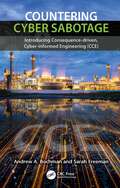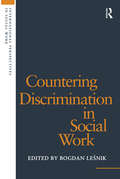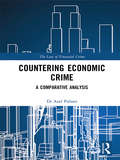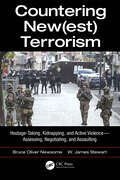- Table View
- List View
Count on Yourself
by Alison GriffithsFrom award-winning financial journalist Alison Griffiths--an empowering, motivating guide that demystifies personal finance and helps you take control of your money.Do you toss your investment and banking statements in a box, unopened? Does the word "investment" make you frown? Are you afraid to look at your money during a recession? Are you worried that you'll have to retire to the back seat of your car? Alison Griffiths gives you easy, prescriptive advice on how to take charge of your money. Learn where to put your money so that it stays safe through market fluctuations. Figure out how bank and investment fees work, and decide for yourself if you're getting enough value for your money. Alison Griffiths is hugely insightful, frank, yet empathetic. If you're going to take any financial advice, you should take it from her...
Count on Yourself
by Alison GriffithsFrom award-winning financial journalist Alison Griffiths--an empowering, motivating guide that demystifies personal finance and helps you take control of your money.Do you toss your investment and banking statements in a box, unopened? Does the word "investment" make you frown? Are you afraid to look at your money during a recession? Are you worried that you'll have to retire to the back seat of your car?Alison Griffiths gives you easy, prescriptive advice on how to take charge of your money. Learn where to put your money so that it stays safe through market fluctuations. Figure out how bank and investment fees work, and decide for yourself if you're getting enough value for your money.Alison Griffiths is hugely insightful, frank, yet empathetic. If you're going to take any financial advice, you should take it from her...
Count on Yourself
by Alison GriffithsFrom award-winning financial journalist Alison Griffiths--an empowering, motivating guide that demystifies personal finance and helps you take control of your money.Do you toss your investment and banking statements in a box, unopened? Does the word "investment" make you frown? Are you afraid to look at your money during a recession? Are you worried that you'll have to retire to the back seat of your car?Alison Griffiths gives you easy, prescriptive advice on how to take charge of your money. Learn where to put your money so that it stays safe through market fluctuations. Figure out how bank and investment fees work, and decide for yourself if you're getting enough value for your money.Alison Griffiths is hugely insightful, frank, yet empathetic. If you're going to take any financial advice, you should take it from her...
Counter Mentor Leadership: How to Unlock the Potential of the 4-Generation Workplace
by Kelly Riggs Robby RiggsThis book is the result of over twenty-five years of combined experience from Kelly and Robby Riggs-dynamic, occasionally irreverent, always insightful, father (Boomer) and son (Millennial), who work with organizations grappling daily with multi-generational conflict. Through their collaboration, Kelly and Robby share their very different perspectives on the same problems most companies are STILL dealing with, but haven't had the courage or the tools, to address. Issues such as: a shocking lack of leadership skills; the culture-killing generational divide that is demolishing many companies; and the stunning, often unrecognized impact of technology on the workplace. In their "shamelessly funny, brilliantly written" debut book, Kelly and Robby will:· Discuss today's workplace dynamics, including the changes in communication modes, the influx of technology, and the impact of Millennials and Digital Natives · Explain how a one-sided approach to leadership focused on "managing" Millennials is grossly insufficient, resulting in an inability to attract and retain critical young talent· Explore the new challenges of leadership inherent with the explosion of technology-time compression, distractions, complexity and the pace of change· Reveal how old leadership challenges persist, and explore how the younger generation will expose those challenges more than ever· Detail the CounterMentor leadership model and prescribe specific tactics and techniques for addressing both old and new leadership issues
Counter Mentor Leadership: How to Unlock the Potential of the 4-Generation Workplace
by Kelly Riggs Robby RiggsThis book is the result of over twenty-five years of combined experience from Kelly and Robby Riggs-dynamic, occasionally irreverent, always insightful, father (Boomer) and son (Millennial), who work with organizations grappling daily with multi-generational conflict. Through their collaboration, Kelly and Robby share their very different perspectives on the same problems most companies are STILL dealing with, but haven't had the courage or the tools, to address. Issues such as: a shocking lack of leadership skills; the culture-killing generational divide that is demolishing many companies; and the stunning, often unrecognized impact of technology on the workplace. In their "shamelessly funny, brilliantly written" debut book, Kelly and Robby will: · Discuss today's workplace dynamics, including the changes in communication modes, the influx of technology, and the impact of Millennials and Digital Natives · Explain how a one-sided approach to leadership focused on "managing" Millennials is grossly insufficient, resulting in an inability to attract and retain critical young talent· Explore the new challenges of leadership inherent with the explosion of technology-time compression, distractions, complexity and the pace of change· Reveal how old leadership challenges persist, and explore how the younger generation will expose those challenges more than ever· Detail the CounterMentor leadership model and prescribe specific tactics and techniques for addressing both old and new leadership issues
Counter Strategies im globalen Wettbewerb
by Olaf PlötnerDie Wettbewerbssituation etablierter Technologieunternehmen verändert sich mit neuen Kunden und Wettbewerben aus den Schwellen- und Entwicklungsländern rasant. Anders als gewohnt, verlangen die neuen Käufer über technisch perfekte Produkte hinaus preiswerte Alternativen. Der Autor diskutiert neue Strategien, mit denen sich Technologieunternehmen erfolgreich behaupten können und liefert Vorschläge für die Umsetzung bei der Produkt- und Preisgestaltung, der Mitarbeiter- und Organisationsentwicklung sowie beim Marken- und Vertriebsmanagement.
Counter Strategies in Global Markets
by Olaf PloetnerDeveloping BRIC markets are changing the business models of traditional western technology leaders. Classic business strategies are no longer suitable for companies attacking abroad whilst defending their market at home. Based on real-life cases, the book evaluates the best new strategies for western companies in technology-based B2B markets.
Counter-Cola: A Multinational History of the Global Corporation
by Amanda CiafoneCounter-Cola charts the history of one of the world’s most influential and widely known corporations, The Coca-Cola Company. Over the past 130 years, the corporation has sought to make its products, brands, and business central to daily life in over 200 countries. Amanda Ciafone uses this example of global capitalism to reveal the pursuit of corporate power within the key economic transformations—liberal, developmentalist, neoliberal—of the twentieth and twenty-first centuries. Coca-Cola's success has not gone uncontested. People throughout the world have redeployed the corporation, its commodities, and brand images to challenge the injustices of daily life under capitalism. As Ciafone shows, assertions of national economic interests, critiques of cultural homogenization, fights for workers’ rights, movements for environmental justice, and debates over public health have obliged the corporation to justify itself in terms of the common good, demonstrating capitalism’s imperative to either assimilate critiques or reveal its limits.
Counter-Narratives and Organization (Routledge Studies in Management, Organizations and Society #39)
by Timothy Kuhn Sanne Frandsen Marianne Wolff LundholtCounter-Narratives and Organization brings the concept of "counter-narrative" into an organizational context, illuminating these complex elements of communication as intrinsic yet largely unexplored aspect of organizational storytelling. Departing from dialogical, emergent and processual perspectives on "organization," the individual chapters focus on the character of counter-narratives, along with their performative aspects, by addressing questions such as: how do some narratives gain dominance over others? how do narratives intersect, relate and reinforce each other how are organizational members and external stakeholders engaged in the telling and re-telling of the organization? The empirical case studies provide much needed insights on the function of counter-narratives for individuals, professionals and organizations in navigating, challenging, negotiating and replacing established dominant narratives about "who we are," "what we believe," "what we do" as a collective. The book has an interdisciplinary scope, drawing together ideas from both storytelling in organization studies, the communicative constitution of organization (CCO) from organizational communication, and traditional narratology from humanities. Counter-Narratives and Organization reflects an ambition to spark readers’ imagination, recognition, and discussion of organization and counter-narratives, offering a route to bring this important concept to the center of our understandings of organization.
Counter-Piracy Law in Practice: An Ethnography of International Security Governance
by Jessica LarsenThis book is a socio-legal study of counter-piracy. It takes as its case the law enforcement efforts after 2008 to suppress piracy off the coast of Somalia. Through ethnographic fieldwork, the book invites the reader onto a Danish warship patrolling the western Indian Ocean for piracy incidents and into the courtroom in Seychelles, where more than 150 suspects were prosecuted. The aim is to understand how counter-piracy worked in practice. The book uses assemblage theory to approach law as a social process and places emphasis on studying empirical enforcement practices over analysing legal provisions. This supplements existing scholarship on the legal aspects of counter-piracy. Scholarship has mainly examined applicable law governing counter-piracy. This book steps into the field to examine applied law. Its methodology renders visible areas of legal ambiguity and identifies practices that suggest impunity and question legal certainty. It thus contributes with new policy-relevant knowledge for international security governance. The relevance is one of urgency. Counter-piracy off Somalia has served as a governance paradigm, which is replicated in other maritime domains. Consideration of the implications for policy is therefore needed. The book will be of interest to policy-makers, security practitioners and scholars who share a methodological commitment to practice.
Counter-Terrorism Community Engagement: Pitfalls and Opportunities (Routledge Studies in Countering Violent Extremism)
by Jason HartleyThis book offers insights into the building of trust in Muslim communities through community engagement in a climate of counter-terrorism. Police engagement with Muslim communities is complex with a history of distrust. This book first attempts to understand the role and implications of uncertainty on community engagement in Muslim communities, and then explores the cultural nuances associated with the demonstration of trustworthiness, and decisions to bestow trust. It further highlights the complexities and implications for Muslim leaders when trying to simultaneously engage police and appease their own communities; the book exposes community perceptions of an over-reaction by authorities that has moved suspicion from a handful of terrorists to the entire Muslim community, resulting in problematic community perceptions that Muslim communities are being targeted by police. The findings suggest that the intentionality of police is a highly significant consideration in trust negotiations, and reveals a number of cultural preferences considered critical to trust negotiations. The book further highlights opportunities to enhance the development of trust and avoid pitfalls that can be problematic to community engagement. The lessons learned seek to enhance the existing body of literature regarding strategies and resources to improve counter-terrorism community engagement with Muslim communities. This book will be of much interest to students of counter-terrorism, preventing violent extremism, deradicalization, and security studies.
Counter-Terrorism Technologies: A Critical Assessment (Advanced Sciences and Technologies for Security Applications)
by Peter LehrThis book critically discusses the role of technology for counter-terrorism in general, and for securing our vulnerable open societies in particular. It is set against the backdrop of the terrorist threat posed by the combined forces of Al Qaeda and ISIS/Daesh in the foreseeable future. The book commences by illuminating current and foreseeable tactics and weapons used by these implacable enemies – weapons that may well include chemical, biological, radiological and potentially even nuclear (CBRN) devices. In a second part, it introduces technologies already available or in development that promise an increase in safety and security when it comes to the dangers posed by these terrorists. This part also includes a critical discussion of advantages and disadvantages of such technologies that are, quite often, sold as a ‘silver bullet’ approach in the fight against terrorism. Controversies such as those triggered by the abuse of millimeter wave scanners deployed at several Western European airports will demonstrate that there are costs involved with regard to human rights. The third, analytical part takes the critical discussion further by arguing that the uncritical fielding of new surveillance and control technologies in parallel with the on-going outsourcing and privatization of key services of the state could well lead to dystopias as envisaged in a rather prescient way by the so-called cyperpunk novels of the 1980s. The book concludes with the question that any liberal democracy should ask itself: how far can we go with regard to hardening our societies against terrorist threats?
Counter-Terrorist Financing Law and Policy: An analysis of Turkey (The Law of Financial Crime)
by Burke Uğur Başaranel Umut TürkşenSince the 9/11 attacks the world has witnessed the creation of both domestic and international legal instruments designed to disrupt and interdict the financial activities of terrorists. This book analyses the counter-terrorist financing law (CTF), policy and practice at the national level, focusing on Turkey. The work examines the limits and capabilities of CTF efforts on terrorism threats and determines the effectiveness of CTF efforts in Turkey, a country which has a pivotal role in terms of countering terrorism regionally and internationally. <P><P>The Turkish case-study is supported by an empirical study involving 37 semi-structured interviews with CTF practitioners and law enforcement experts with different affiliations and backgrounds. The findings illustrate that Turkey’s CTF system has not obtained an adequate level of effectiveness as a result of lack of proper implementation of its policy in the bureaucratic, legal and operational spheres. It is evident that the administrative and legal systems in Turkey are established according to the ‘one-size-fits-all’ international CTF standards and thus are compliant with the international CTF benchmarks, yet the interviews reveal significant challenges at the implementation level including lack of training and financial security, heavy handed bureaucracy, inadequate coordination and communication between international and national levels. <P><P>The book will be an invaluable resource for academics, students and policy-makers working in the areas of financial crime and terrorism.
Countercyclical Macro Prudential Policies in a Supporting Role to Monetary Policy
by Papa N'DiayeA report from the International Monetary Fund.
Counterfeit Crime
by R. T. NaylorIn Counterfeit Crime, economist, historian, and criminologist R.T. Naylor dissects the costs - economic, social, and political - of the seemingly never-ending wars on the grossly exaggerated menaces of Crime and Terror and how most things politicians do to combat them make matters worse - for the public and the public good. He explains how the post-World War II welfare state, with its commitment to building public infrastructure, maintaining social security, and providing accessible education, gave way to the modern executive state, with its focus on guaranteeing corporate welfare, dropping bombs on countries too weak to fight back, and manipulating the thoughts and actions of populations kept in line by the carrot of glitzy toys and the stick of ever-heavier legal sanctions. He dissects how the canons of free-market fundamentalism, backed by the cannons of state power, paved the road toward a soft form of totalitarianism, which march hand in hand with millennial Christianity and a military-security-industrial complex in search for new - mostly imaginary - enemies. Counterfeit Crime is savage in its critique of the political and judicial status quo and outraged at an economy rife with corruption.
Counterfeit Crime: Criminal Profits, Terror Dollars, and Nonsense
by R.T. NaylorIn Counterfeit Crime, economist, historian, and criminologist R.T. Naylor dissects the costs - economic, social, and political - of the seemingly never-ending wars on the grossly exaggerated menaces of Crime and Terror and how most things politicians do to combat them make matters worse - for the public and the public good. He explains how the post-World War II welfare state, with its commitment to building public infrastructure, maintaining social security, and providing accessible education, gave way to the modern executive state, with its focus on guaranteeing corporate welfare, dropping bombs on countries too weak to fight back, and manipulating the thoughts and actions of populations kept in line by the carrot of glitzy toys and the stick of ever-heavier legal sanctions. He dissects how the canons of free-market fundamentalism, backed by the cannons of state power, paved the road toward a soft form of totalitarianism, which march hand in hand with millennial Christianity and a military-security-industrial complex in search for new - mostly imaginary - enemies. Counterfeit Crime is savage in its critique of the political and judicial status quo and outraged at an economy rife with corruption.
Counterfeit Luxury and Consumption (Routledge Studies in Luxury Management)
by António Carrizo Moreira Cláudio Félix Canguende-Valentim Vera Teixeira ValeCounterfeiting is a widespread problem in the luxury market. To develop appropriate countermeasures, a comprehensive understanding of this phenomenon is crucial. This book provides a holistic approach to explore counterfeit luxury consumption.This edited volume seeks to identify new trends by examining three levels of analysis. First, it explores the macro level related to the brand, including corporate decisions and marketing strategies. Second, the meso level focuses on the influence of interpersonal and sociocultural contexts. Thirdly, the micro level examines intrapersonal and situational contingencies. With contributions from international experts, the book provides broad perspectives from both the demand and supply side of luxury counterfeiting, offering valuable insights to help mitigate the issue and improve counter strategies.Counterfeit Luxury and Consumption will be of interest to researchers, postgraduate students, and policymakers across the fields of luxury management, marketing, consumer behavior, brand management, and ethical and responsible business.
Counterfeited in China: The Operations of Illicit Businesses
by Ko-Lin ChinCounterfeiting tops the list of organized crimes committed worldwide, raking in nearly half a trillion dollars in 2019. The impact of this illicit business is felt by consumers, brand owners, state authorities, and workers, and it impacts the economy. Moreover, its proliferation has fueled the advancement of organized crime groups. In his illuminating study, Counterfeited in China, Ko-lin Chin investigates this lucrative industry and its emergence in China. His face-to-face interviews with counterfeiters — business owners, workers, facilitators, and key informants — in the hub of Guangzhou, China reveal how businesses that design, produce, and distribute fake and unauthorized luxury goods manage the risks inherent in their business. Counterfeited in China examines the individual and group characteristics of counterfeiters and their relationships with organized crime; analyzes the economic aspects of counterfeiting; assesses the relationships among counterfeiting, violence, and corruption; and seeks to understand the demand for counterfeit goods. Chin also discusses the role of Chinese authorities and other parties in the war against counterfeiting. Assessing the state of the industry and its future, Chin provides fascinating new insights into the modus operandi of counterfeiters.
Countering 21st Century Social-Environmental Threats to Growing Global Populations (SpringerBriefs in Environmental Science)
by Frederic R. SiegelThis book brings together in a single volume a grand overview of solutions - political, economic, and scientific - to social and environmental problems that are related to the growth of human populations in areas that can least cope with them now. Through progressive adaptation to social and environmental changes projected for the future, including population growth, global warming/climate change, water deficits, and increasing competition for other natural resources, the world may be able to achieve a fair degree of sustainability for some time into the future.
Countering Brandjacking in the Digital Age: … and Other Hidden Risks to Your Brand (SpringerBriefs in Computer Science)
by Christopher Hofman Simeon KeatesThe rise of the Internet and social media in particular offer great opportunities for brand owners to increase business and brand recognition. While this has clearly been of benefit to brand owners, who have seen a consequent rise in the value of their brands, it simultaneously makes those brands more attractive for exploitation or attack by others. Brand risks can come in many different types and this book provides examples of how these risks can arise as well as providing quantitative estimates of the adverse impacts that can result from such risks. Brand owners need to be aware of the risks and of the need to develop strategies for identifying and managing them. This book details the process by which a brand owner can develop a brand risk management process to protect a brand's reputation and value. Rather than prescribe a one-size-fits-all approach, the authors provide guidance on how a brand risk management process can be tailored to particular needs and circumstances. This approach is underpinned by drawing on examples of best practice in the fields of risk management, interaction design and engineering design. This combined approach relies on developing an understanding of the risks faced by a particular brand owner, the full context of those risks and also the brand owner's capabilities for identifying and managing those risks. This book contains many real-world examples and interviews with a number of brand owning organisations ranging from small companies to large multinationals.
Countering Cyber Sabotage: Introducing Consequence-Driven, Cyber-Informed Engineering (CCE)
by Sarah Freeman Andrew A. BochmanCountering Cyber Sabotage: Introducing Consequence-Driven, Cyber-Informed Engineering (CCE) introduces a new methodology to help critical infrastructure owners, operators and their security practitioners make demonstrable improvements in securing their most important functions and processes. Current best practice approaches to cyber defense struggle to stop targeted attackers from creating potentially catastrophic results. From a national security perspective, it is not just the damage to the military, the economy, or essential critical infrastructure companies that is a concern. It is the cumulative, downstream effects from potential regional blackouts, military mission kills, transportation stoppages, water delivery or treatment issues, and so on. CCE is a validation that engineering first principles can be applied to the most important cybersecurity challenges and in so doing, protect organizations in ways current approaches do not. The most pressing threat is cyber-enabled sabotage, and CCE begins with the assumption that well-resourced, adaptive adversaries are already in and have been for some time, undetected and perhaps undetectable. Chapter 1 recaps the current and near-future states of digital technologies in critical infrastructure and the implications of our near-total dependence on them. Chapters 2 and 3 describe the origins of the methodology and set the stage for the more in-depth examination that follows. Chapter 4 describes how to prepare for an engagement, and chapters 5-8 address each of the four phases. The CCE phase chapters take the reader on a more granular walkthrough of the methodology with examples from the field, phase objectives, and the steps to take in each phase. Concluding chapter 9 covers training options and looks towards a future where these concepts are scaled more broadly.
Countering Discrimination in Social Work (International Perspectives in Social Work)
by Bogdan LešnikDiscrimination? Isn't there enough talk about discrimination? Yes, indeed. That is why we have to begin countering discrimination. We need strategies that will make it inoperative or at least limit its scope. But first, we need to think how discrimination works and identify it where it works. It concerns far more than mere procedural hitches for which a few legal provisions will do. Countering Discrimination (Volume 1998 of International Perspectives in Social Work yearbook) brings papers that analyse mechanisms of social discrimination in a variety of such locations and bring proposals for counter-strategies. This is essential in social work if causes, rather than manifestations, of the problems it is concerned with are to be addressed. But it is also essential that everybody who opposes discrimination recognise its subtle and dispersed ways of operation in the human services, regardless of their own basic field of work. In this respect, the book will be useful to a very wide audience.
Countering Economic Crime: A Comparative Analysis (The Law of Financial Crime)
by Axel PalmerEconomic crime is a significant feature of the UK’s economic landscape and yet despite the government’s bold mission statements ‘to hold those suspected of financial wrongdoing to account’ as part of their ‘day of reckoning’ and ‘serious about white-collar crime’ agenda, there is a sense that this is still not being done effectively. This book examines the history of the creation of the UK’s anti-economic crime institutions and accompanying legislation, providing a critique of their effectiveness. The book analyses whether the recent regulatory regime is fit for purpose as well as being appropriate for the future. In order to explore how the UK’s economic crime strategies could be improved the book takes a comparative approach analysing policy and legislative responses to economic crime in the United States and Australia in order to determine whether the UK could or should import similar structures or laws to improve the enforcement of UK economic crime.
Countering Fraud for Competitive Advantage
by Mark Button Jim GeeSubstantially reduce the largely hidden cost of fraud, and reap a new competitive advantage. As the title suggests, Countering Fraud for Competitive Advantage presents a compelling business case for investing in anti-fraud measures to counter financial crime. It looks at the ways of reaping a new competitive advantage by substantially reducing the hidden cost of fraud. Aimed at a wide business community and based on solid research, it is the only book to put forward an evidence-based model for combating corporate fraud and financial crime. Despite its increase and capture of the news headlines, corporate fraud is largely ignored by most organizations. Fraud is responsible for losses of up to nine percent of revenues--sometimes more. Yet, most organizations don't believe they have a problem and don't always measure fraud losses. This highlights an area for capturing a competitive advantage--with the right counter-fraud strategy, massive losses due to the cost of fraud can be reduced for a fraction of the return. Advocates a new model for tackling fraud and illustrates theories with best practice examples from around the world The authors have close links with the Counter Fraud Professional Accreditation Board: Jim Gee is a world-renowned expert in the field, and has advised private companies and governments from more than 35 countries. Mark Button is Director of the leading Centre for Counter Fraud Studies, Portsmouth University, U.K. Organizations are losing millions of dollars to fraud. This book outlines a comprehensive approach to reducing financial crime and helping return some of the revenue lost to the cost of fraud.
Countering New(est) Terrorism: Hostage-Taking, Kidnapping, and Active Violence — Assessing, Negotiating, and Assaulting
by Bruce Oliver Newsome James W. Stewart Aarefah MosaviHow should we analyze and assess new terrorist behaviors? What are the particular risks and challenges from new terrorism? Should we negotiate with terrorists, and, if so, how? When should we use force against terrorists? Countering New(est) Terrorism: Hostage-Taking, Kidnapping, and Active Violence—Assessing, Negotiating, and Assaulting improves our knowledge of new terrorist behaviors, and our skills in responding to such attacks. The term "new terrorism" has been in circulation since the late 90’s. This book analyzes the "newest terrorism" that has emerged in recent years—characterized by increased hostage-taking, kidnapping, and active violence—and develops best practices for countering these emerging threats. Along the way, it challenges fashionable wishful thinking that all terrorists are open to rational negotiation or de-radicalization, that military responses always reflect badly on the official side, and that terrorists are not constrained by their own doctrines. The new terrorists are dramatically more ideological, murderous, and suicidal. They are generally less reconcilable, less trusting of official negotiators, less likely to release detainees, and more likely to kill detainees. They are less likely to demand ransoms yet more likely to release hostages in cases in which they do demand ransom. They are more informed about the official side’s policies, tactics, techniques, and procedures. They are more likely to use new information and communication technologies against responding agencies and officials. They are more capable fighters—they kill more people despite deploying fewer fighters per hostage. Most disturbing is the fact that they take advantage of free-er societies to access easier targets. Features: Includes evidence-based definitions and descriptions of political, religious, Jihadi, and new terrorism Presents the first large-n comparison of old and new terrorism, using an original extension of the Global Terrorism Database (GTD), with added codes for each of 10,735 hostage crises and more than 500,000 data points from 1970 through 2016 Details a further extension of the GTD covering all terrorist events from 2004 through 2016, roughly 5 million data points. Offers prescriptive advice and visual decision trees on how to negotiate crises, assess the risk of terrorism, and how and when to assault terrorists Reviews official practices, interviews with experienced officials, and real-world simulations of recent terrorist events and attacks Countering New(est) Terrorism will be of interest to researchers, students enrolled in terrorism and Homeland Security programs, crisis negotiators, and police, security, intelligence, and military authorities tasked with counterterrorism and anti-terrorism efforts.

